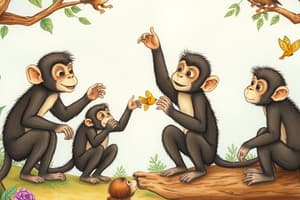Podcast
Questions and Answers
Which method was used to assess the effect of various factors on the delta score?
Which method was used to assess the effect of various factors on the delta score?
- Principal component analysis
- Spearman’s rho-correlations
- Landau’s linearity indices
- Generalised linear mixed model (correct)
What behaviour did male ravens display in response to playbacks that violated dominance relations?
What behaviour did male ravens display in response to playbacks that violated dominance relations?
- Aggressive vocalisation
- Calm and submissive behaviour
- No change in behaviour
- Increased stress behaviour (correct)
What impact did simulated rank reversals in the subjects' own group have on the ravens?
What impact did simulated rank reversals in the subjects' own group have on the ravens?
- Aggressive displays towards each other
- Increased activity levels (correct)
- No observable reactions
- Decreased vocalisation
Which analysis method was employed to reduce the number of response variables?
Which analysis method was employed to reduce the number of response variables?
What was revealed about ravens when playback stimuli concerned simulated rank reversals in a neighbouring group?
What was revealed about ravens when playback stimuli concerned simulated rank reversals in a neighbouring group?
What did the results suggest about ravens' understanding of their social hierarchy?
What did the results suggest about ravens' understanding of their social hierarchy?
What behaviour pattern did females exhibit in response to stress-inducing simulated rank reversals in their group?
What behaviour pattern did females exhibit in response to stress-inducing simulated rank reversals in their group?
What correlation was used to measure inter-rater reliability concerning durational behaviours?
What correlation was used to measure inter-rater reliability concerning durational behaviours?
What can be inferred about the capability of apes regarding false-belief understanding based on the evidence provided?
What can be inferred about the capability of apes regarding false-belief understanding based on the evidence provided?
What aspect of the tasks may influence the differential performance observed between apes and humans?
What aspect of the tasks may influence the differential performance observed between apes and humans?
In the context of the experimental tasks, what strategy might apes apply when trying to predict an actor's search behavior?
In the context of the experimental tasks, what strategy might apes apply when trying to predict an actor's search behavior?
How do the findings regarding ape theory of mind (TOM) contribute to the understanding of its evolution?
How do the findings regarding ape theory of mind (TOM) contribute to the understanding of its evolution?
What is a potential limitation of using an abstract behavior rule-based explanation for apes solving false-belief tasks?
What is a potential limitation of using an abstract behavior rule-based explanation for apes solving false-belief tasks?
What defines zero intentionality in behavior?
What defines zero intentionality in behavior?
Which statement best describes first order intentionality?
Which statement best describes first order intentionality?
Why is Occam's razor considered risky in biological research?
Why is Occam's razor considered risky in biological research?
In terms of goal achievement in woodlice, what is suggested about their behavior?
In terms of goal achievement in woodlice, what is suggested about their behavior?
What best describes the role of cognition in behavior?
What best describes the role of cognition in behavior?
What does the theory of mind (ToM) enable individuals to do?
What does the theory of mind (ToM) enable individuals to do?
How did rats exhibit intention in the experiments mentioned?
How did rats exhibit intention in the experiments mentioned?
What indicates the concept of second order intentionality?
What indicates the concept of second order intentionality?
What are the two categories of divided incomplete exchanges identified?
What are the two categories of divided incomplete exchanges identified?
What action does NOT count as an exchange in the token experiment?
What action does NOT count as an exchange in the token experiment?
What emotion do capuchin monkeys demonstrate when comparing rewards?
What emotion do capuchin monkeys demonstrate when comparing rewards?
How long do monkeys have to place the token into the experimenter's hand?
How long do monkeys have to place the token into the experimenter's hand?
What was the outcome measured to determine the rate of exchange failure?
What was the outcome measured to determine the rate of exchange failure?
What concept is proposed to guide nonhuman primates in their exchanges?
What concept is proposed to guide nonhuman primates in their exchanges?
What statistical method was used to conduct pair-wise comparisons in the study?
What statistical method was used to conduct pair-wise comparisons in the study?
In the exchange interactions, how successful were the subjects in completing exchanges during baseline tests?
In the exchange interactions, how successful were the subjects in completing exchanges during baseline tests?
What behavior do fish exhibit when a colored tag is provided in a modified mark test?
What behavior do fish exhibit when a colored tag is provided in a modified mark test?
In the Sally-Anne test, where will Sally look for her ball after Anne has moved it?
In the Sally-Anne test, where will Sally look for her ball after Anne has moved it?
What was the result concerning the performance of children and great apes on false belief tasks?
What was the result concerning the performance of children and great apes on false belief tasks?
What does gaze following indicate in monkeys, as evidenced by studies with actors?
What does gaze following indicate in monkeys, as evidenced by studies with actors?
What does the high-level explanation of perspective taking involve?
What does the high-level explanation of perspective taking involve?
In experiments on visual perspective, what behavior did monkeys exhibit when watched by humans?
In experiments on visual perspective, what behavior did monkeys exhibit when watched by humans?
How do monkeys differentiate between body and face orientation of an observer?
How do monkeys differentiate between body and face orientation of an observer?
What did the experiment involving long-tailed macaques during a food competition reveal?
What did the experiment involving long-tailed macaques during a food competition reveal?
What type of deceptive behavior was observed in monkeys?
What type of deceptive behavior was observed in monkeys?
What capacity do ravens exhibit according to their behavior regarding visual access?
What capacity do ravens exhibit according to their behavior regarding visual access?
Which species of apes succeeded in high-level false belief tasks?
Which species of apes succeeded in high-level false belief tasks?
What was a common finding in gaze-following experiments with long-tailed macaques?
What was a common finding in gaze-following experiments with long-tailed macaques?
What behavior do great apes and long-tailed macaques share regarding gaze following?
What behavior do great apes and long-tailed macaques share regarding gaze following?
In terms of behavior reading, what is one limitation noted about chimpanzees?
In terms of behavior reading, what is one limitation noted about chimpanzees?
Study Notes
Incomplete Exchanges in Monkeys
- Incomplete exchanges in monkeys can be categorized into two types: failure to hand back the token (NT) and failure to accept the reward (RR).
- Active rejection often occurs in both categories, such as throwing the token or reward away.
- In exchange tasks, monkeys received a token and exchanged it for a food reward.
- Successful exchange involved placing the token in the experimenter’s outstretched hand within 60 seconds.
- Throwing the token did not count as an exchange.
- Reward was given after successful exchange.
- 95% or more of monkeys successfully exchanged in baseline tests.
- Monkeys had at least 2 years of experience with the exchange scheme.
Relative Reward in Monkeys
- Capuchin monkeys show evidence of measuring reward in relative terms, comparing their own rewards with those of others.
- Negative reactions occur when a partner receives a better deal than the monkey.
Social Rank in Ravens
- Ravens exhibit different behaviors after playbacks simulating a rank reversal in their group.
- Playbacks were used to investigate the ravens' understanding of social hierarchy.
- Simulation of a rank reversal caused stress and changes in activity levels.
- Ravens were more reactive when the simulated reversal was about members of their own sex.
- Ravens showed no signs of stress or activity when playbacks suggested rank reversals in a neighboring group.
- Male ravens responded specifically to playbacks violating the dominance relations of their neighboring group.
Theory of Mind: Understanding Others' Minds
- Theory of Mind (ToM) is the ability to understand that others have a “mind” and thoughts, beliefs, and intentions different from our own.
- ToM is often considered a hallmark of higher cognitive abilities.
- False belief is an important aspect of ToM.
- The Sally-Anne test is used to assess false belief understanding.
- Great apes have shown some evidence of understanding false beliefs.
- Gaze following is considered a potential indicator of ToM.
- Long-tailed macaques have shown gaze following and sensitivity to facial expressions.
- Perspective taking involves understanding the visual perspective of others.
- Great apes can follow gaze around barriers, demonstrating perspective taking.
- Deception is another behaviour related to ToM.
- Monkeys have been observed engaging in deceptive behavior, for example, grooming another monkey behind a rock.
- Occam’s razor is a principle that suggests the simplest explanation is often the best.
- It is important to avoid oversimplification when studying animal behavior.
- Woodlice exhibit a “goal-achieving system” even though their behavior is based on emergent distribution.
Intentionality and Goals
- Intentionality refers to the ability to have a goal and act intentionally to achieve it.
- Rats can demonstrate intentional behavior when rewarded with sugar.
- Intentional states include the idea that a goal can be achieved through action and the will to reach the goal.
- Plover's distraction behavior is an example of how behavior can be functional to achieve a specific goal.
- First-order intentionality involves understanding the effect of one's behavior on others.
- Second-order intentionality involves understanding what others think about one's behavior.
Studying That Suits You
Use AI to generate personalized quizzes and flashcards to suit your learning preferences.
Related Documents
Description
Explore the fascinating behavioral patterns of monkeys during exchange tasks, including their responses to incomplete exchanges and relative rewards. Learn how social rank influences their behavior and emotional reactions in competitive settings. This quiz will delve into the intricacies of monkey social interactions and reward assessment.





